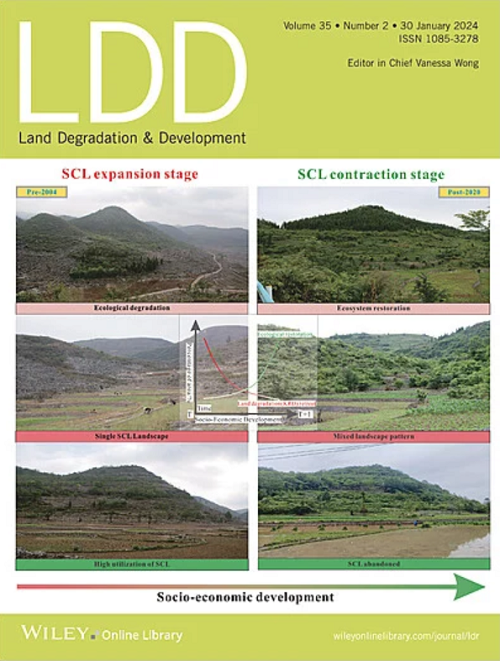Species Rarity and Topography Determine the Plant Functional Structure Along the Successional Pathway in Heterogeneous Degraded Karst Forests
IF 3.6
2区 农林科学
Q2 ENVIRONMENTAL SCIENCES
引用次数: 0
Abstract
Understanding the dynamics of plant functional community structure along the successional pathway is crucial for natural resource conservation and environmental management, especially in those specially degraded ecosystems. This study established forest dynamic plots along the successional pathway in degraded karst forests to measure six plant functional traits: specific leaf area, leaf dry matter content, leaf thickness, leaf carbon content, leaf nitrogen content, and leaf phosphorus content. By implementing Grime's CSR strategy and employing a ternary functional diversity diagram framework, the variations in ternary plant ecological strategies and functional diversity were quantified. The results showed that the plants with competitive strategies increased along the succession, while plants with S-strategy decreased. The functional diversity declined from the early- to mid-successional stages, followed by an increase in the late-successional stage, with a corresponding inverse trend in functional redundancy. Furthermore, there was a decrease in species dominance from the early- to mid-successional stage, which contributed to the trade-off between functional diversity and redundancy. The topographic roughness and soil pH value were the main abiotic factors determining the variation in functional diversity among successional stages. Species rarity positively impacted functional diversity but negatively affected functional redundancy, highlighting the role of rare species in maintaining ecosystem functionality and emphasizing the vulnerability of karst ecosystems to environmental changes. This study provides valuable insights into the successional mechanisms in karst forests, thereby facilitating the development of effective conservation and environmental management.非均质退化喀斯特森林演替路径中物种稀有度和地形决定植物功能结构
了解演替路径上植物功能群落结构的动态变化对自然资源保护和环境管理具有重要意义,特别是在那些特别退化的生态系统中。本研究在退化喀斯特森林的演替路径上建立了森林动态样地,测量了6个植物功能性状:比叶面积、叶干物质含量、叶厚度、叶碳含量、叶氮含量和叶磷含量。通过实施Grime的企业社会责任战略,采用三元功能多样性图框架,量化了三元植物生态策略和功能多样性的变化。结果表明:在演替过程中,具有竞争策略的植物数量增加,而具有s策略的植物数量减少;功能多样性在演替前期至中期呈下降趋势,在演替后期呈上升趋势,功能冗余度呈相反趋势。此外,从演替早期到演替中期,物种优势度呈下降趋势,这有助于在功能多样性和冗余之间进行权衡。地形粗糙度和土壤pH值是决定不同演替阶段功能多样性变化的主要非生物因子。物种稀有性对功能多样性有正向影响,但对功能冗余有负向影响,突出了稀有物种在维持生态系统功能中的作用,强调了喀斯特生态系统对环境变化的脆弱性。该研究为喀斯特森林演替机制的研究提供了有价值的见解,有助于开展有效的保护和环境管理。
本文章由计算机程序翻译,如有差异,请以英文原文为准。
求助全文
约1分钟内获得全文
求助全文
来源期刊

Land Degradation & Development
农林科学-环境科学
CiteScore
7.70
自引率
8.50%
发文量
379
审稿时长
5.5 months
期刊介绍:
Land Degradation & Development is an international journal which seeks to promote rational study of the recognition, monitoring, control and rehabilitation of degradation in terrestrial environments. The journal focuses on:
- what land degradation is;
- what causes land degradation;
- the impacts of land degradation
- the scale of land degradation;
- the history, current status or future trends of land degradation;
- avoidance, mitigation and control of land degradation;
- remedial actions to rehabilitate or restore degraded land;
- sustainable land management.
 求助内容:
求助内容: 应助结果提醒方式:
应助结果提醒方式:


